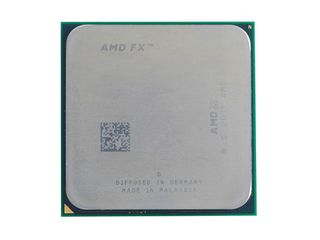Why you can trust TechRadar
What we can say for certain is that the FX 4100 is based on AMD's latest 32nm Bulldozer architecture.
It has two modules and therefore a grand total of four pseudo cores. It runs at 3.6GHz nominally, sports a 3.8GHz Turbo frequency and packs 12MB of L2 and L3 cache memory, combined.
And it's happiest in an AM3+ socket paired with DDR3 memory up to 1,866MHz.
But here's the real kicker. It's yours for just £100.

So, that's healthy clocks, four threads and AMD's very latest CPU architecture. Quite an attractive package. But not, as it turns out, terribly fit for gaming purpose.
The problem is the new AMD Bulldozer microarchitecture. If anything, its strongest suit is multi-threading. And that means you want as many of those modules switched on as possible.
What Bulldozer doesn't deliver, however, is decent per-thread performance.
For proof, first observe the single threaded benchmark results. The 3.6GHz (3.8GHz with Turbo) FX 4100 may be clocked significantly higher the similarly priced 3.1GHz Intel Core i3-2100, but the latter is absolutely off the map in terms of single or few-threaded performance.
The FX 4100 needs three minutes and 44 seconds to churn its way through Cinebench R10 in single-threaded mode. The i3-2100 needs just two minutes and 51 seconds.
Of course, what really matters is actual game performance and here Bulldozer's per-thread gutlessness duly rears its head.
The 67 frames per second average the AMD FX 4100 Black Edition achieves in the World in Conflict test may sound pretty reasonable, but it obscures the fact that the frame rate can, and does, drop well below 30 when the on screen action goes into overdrive.
Meanwhile, the merely dual-core Core i3-2100 cranks out 80- frames per second and generally keeps cooler under pressure.
In our testing, the 4100 didn't deliver significantly better overclocking headroom than the full eight-core Bully.
We liked:
To be honest, apart from the price, there really isn't a lot to like about this even weaker spin of the Bulldozer architecture.
We disliked:
We'd hoped for a lot more from this brand new AMD Bulldozer architecture, but the weak single-core performance, behind even the old Phenom II processors, makes us sad.
We could have forgiven it some of those failings if the gaming performance wasn't just as poor.
Final word:
The best that can be said about this dual-module Bulldozer, then, is that it's not far behind its triple and quad-module brethren in games.
If only they weren't all off the pace.
Contributor
Technology and cars. Increasingly the twain shall meet. Which is handy, because Jeremy (Twitter) is addicted to both. Long-time tech journalist, former editor of iCar magazine and incumbent car guru for T3 magazine, Jeremy reckons in-car technology is about to go thermonuclear. No, not exploding cars. That would be silly. And dangerous. But rather an explosive period of unprecedented innovation. Enjoy the ride.
